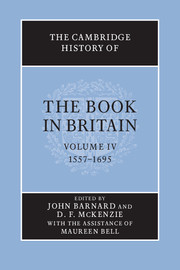Book contents
- Frontmatter
- Dedication
- Contents
- List of illustrations
- List of contributors
- Preface
- Acknowledgements
- Introduction
- RELIGION AND POLITICS
- ORAL TRADITIONS AND SCRIBAL CULTURE
- LITERATURE OF THE LEARNED
- LITERARY CANONS
- VERNACULAR TRADITIONS
- THE BUSINESS OF PRINT AND THE SPACE OF READING
- BEYOND LONDON: PRODUCTION, DISTRIBUTION, RECEPTION
- 32 The English provinces
- 33 Scotland
- 34 The book in Ireland from the Tudor re-conquest to the battle of the Boyne
- 35 Wales
- 36 British books abroad: the Continent
- 37 British books abroad: the American colonies
- DISRUPTION AND RESTRUCTURING: THE LATE SEVENTEENTH-CENTURY BOOK TRADE
- STATISTICAL APPENDICES
- Abbreviations
- Bibliography
- Index
- Plate Section
- References
33 - Scotland
from BEYOND LONDON: PRODUCTION, DISTRIBUTION, RECEPTION
- Frontmatter
- Dedication
- Contents
- List of illustrations
- List of contributors
- Preface
- Acknowledgements
- Introduction
- RELIGION AND POLITICS
- ORAL TRADITIONS AND SCRIBAL CULTURE
- LITERATURE OF THE LEARNED
- LITERARY CANONS
- VERNACULAR TRADITIONS
- THE BUSINESS OF PRINT AND THE SPACE OF READING
- BEYOND LONDON: PRODUCTION, DISTRIBUTION, RECEPTION
- 32 The English provinces
- 33 Scotland
- 34 The book in Ireland from the Tudor re-conquest to the battle of the Boyne
- 35 Wales
- 36 British books abroad: the Continent
- 37 British books abroad: the American colonies
- DISRUPTION AND RESTRUCTURING: THE LATE SEVENTEENTH-CENTURY BOOK TRADE
- STATISTICAL APPENDICES
- Abbreviations
- Bibliography
- Index
- Plate Section
- References
Summary
This sketch of the Scottish book trade outlines some of the principal ways in which the trade at this period, though in some ways similar, was very different from that south of the Border and, more widely, furth of and outwith Scotland. The English legislation that restricted printing to London, Cambridge and Oxford created a concentration of the book-production industry in the south of England. This legislation played its part in isolating that trade from the book trade in the north of England, and still more from that of Scotland. The control of the English Stationers’ Company did not extend to Scotland which, like Holland, had no equivalent regulatory body. While the encouragement of Scottish printing and bookselling was, loosely, a part of government policy, the main non-governmental institutions involved in the control of the trade were the Church and, most importantly, the Scottish burghs, which played a crucial role in censorship, licensing and trade regulation. This local and geographically dispersed control of the trade by the burghs of Aberdeen, Edinburgh and Glasgow resembled more closely the organization of the book trades in the Low Countries than the centralized authority of England. The unified study of book history in the British Isles has been hampered by the contrast between this relatively loose Scottish régime and the monolithic English trade, and by consequent differences in the records each produced: surviving Scottish records are more fragmentary and less copious than those produced by the English Stationers’ Company. Scotland’s own book history has itself suffered from a centralizing tendency which has focused on Edinburgh to the exclusion of Aberdeen and Glasgow; and placing it in the wider British context is frustrated by the fact that many important research projects stop on oneside or other of the Border.
Keywords
- Type
- Chapter
- Information
- The Cambridge History of the Book in Britain , pp. 687 - 700Publisher: Cambridge University PressPrint publication year: 2002
References
- 3
- Cited by



